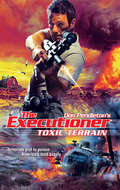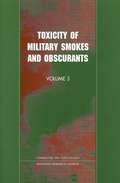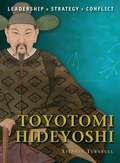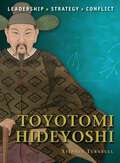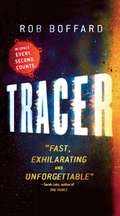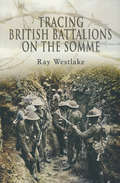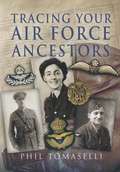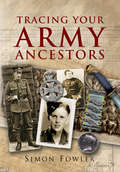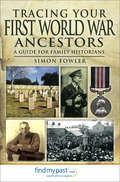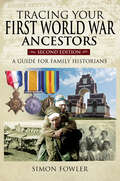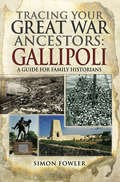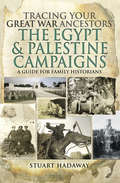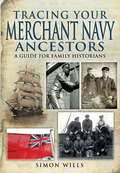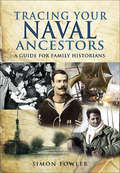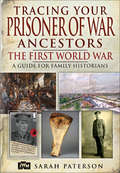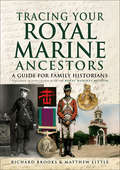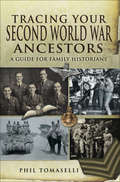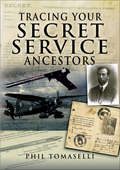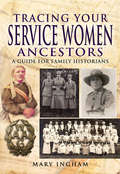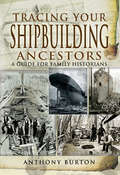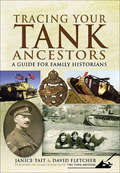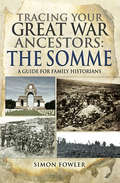- Table View
- List View
Toxic Terrain
by Don PendletonAgCon, the largest distributor of cattle feed in the Midwest, is controlled by retired officers of China's PLA, who have perfected a fast-acting prion to cause mad-cow disease. It's up to Bolan to shut down the operation before they poison the country's food supply.
Toxic War: The Story of Agent Orange
by Peter SillsThe war in Vietnam, spanning more than twenty years, was one of the most divisive conflicts ever to envelop the United States, and its complexity and consequences did not end with the fall of Saigon in 1975. As Peter Sills demonstrates in Toxic War, veterans faced a new enemy beyond post-traumatic stress disorder or debilitating battle injuries. Many of them faced a new, more pernicious, slow-killing enemy: the cancerous effects of Agent Orange.Originally introduced by Dow and other chemical companies as a herbicide in the United States and adopted by the military as a method of deforesting the war zone of Vietnam, in order to deny the enemy cover, Agent Orange also found its way into the systems of numerous active-duty soldiers. Sills argues that manufacturers understood the dangers of this compound and did nothing to protect American soldiers.Toxic War takes the reader behind the scenes into the halls of political power and industry, where the debates about the use of Agent Orange and its potential side effects raged. In the end, the only way these veterans could seek justice was in the court of law and public opinion. Unprecedented in its access to legal, medical, and government documentation, as well as to the personal testimonies of veterans, Toxic War endeavors to explore all sides of this epic battle.
Toxic War: The Story of Agent Orange
by Peter SillsThe war in Vietnam, spanning more than twenty years, was one of the most divisive conflicts ever to envelop the United States, and its complexity and consequences did not end with the fall of Saigon in 1975. As Peter Sills demonstrates in Toxic War, veterans faced a new enemy beyond post-traumatic stress disorder or debilitating battle injuries. Many of them faced a new, more pernicious, slow-killing enemy: the cancerous effects of Agent Orange. Originally introduced by Dow and other chemical companies as a herbicide in the United States and adopted by the military as a method of deforesting the war zone of Vietnam, in order to deny the enemy cover, Agent Orange also found its way into the systems of numerous active-duty soldiers. Sills argues that manufacturers understood the dangers of this compound and did nothing to protect American soldiers.Toxic War takes the reader behind the scenes into the halls of political power and industry, where the debates about the use of Agent Orange and its potential side effects raged. In the end, the only way these veterans could seek justice was in the court of law and public opinion. Unprecedented in its access to legal, medical, and government documentation, as well as to the personal testimonies of veterans, Toxic War endeavors to explore all sides of this epic battle.
Toxicity of Military Smokes and Obscurants: Volume 3
by National Research CouncilThe National Academies Press (NAP)--publisher for the National Academies--publishes more than 200 books a year offering the most authoritative views, definitive information, and groundbreaking recommendations on a wide range of topics in science, engineering, and health. Our books are unique in that they are authored by the nation's leading experts in every scientific field.
Toyotomi Hideyoshi: Leadership, Strategy, Conflict
by Stephen TurnbullArguably the greatest military commander in the history of the samurai, Toyotomi Hideyoshi rose from the ranks of the peasantry to rule over all Japan. A student of the great unifier Oda Nobunaga, Hideyoshi would later avenge the murder of his master at the battle of Yamazaki.
Toyotomi Hideyoshi: The Background, Strategies, Tactics and Battlefield Experiences of the Greatest Commanders of History
by Stephen Turnbull Giuseppe RavaArguably the greatest military commander in the history of the samurai, Toyotomi Hideyoshi rose from the ranks of the peasantry to rule over all Japan. A student of the great unifier Oda Nobunaga, Hideyoshi would later avenge the murder of his master at the battle of Yamazaki. After consolidating his position, Hideyoshi went on the offensive, conquering the southern island of Kyushu in 1587 and defeating the Hojo in 1590. By 1591, he had accomplished the reunification of Japan. This book looks at the complete story of Hideyoshi's military accomplishments, from his days as a tactical leader to his domination of the Japanese nation.
Tracer (Outer Earth #1)
by Rob BoffardImagine The Bourne Identity meets Gravity and you'll get TRACER, the most exciting action thriller set in space you'll ever read.Sarah Lotz, author of The Three calls it "fast, exhilarating and unforgettable."A huge space station orbits the Earth, holding the last of humanity. It's broken, rusted, falling apart. We've wrecked our planet, and now we have to live with the consequences: a new home that's dirty, overcrowded and inescapable.What's more, there's a madman hiding on the station. He's about to unleash chaos. And when he does, there'll be nowhere left to run.In space, every second counts. Who said nobody could hear you scream? "A stunning debut that never lets up, from the nerve-jangling beginning to the explosive end." James Douglas, author of The Doomsday Machine
Tracing British Battalions on the Somme
by Ray WestlakeAlthough seventy-eight years have passed since the Battle of the Somme was fought, interest in this, the bloodiest battle of the First World War, has never waned. Ray Westlake has collated all the information so painstakingly gathered, to produce a comprehensive compendium of the exact movements of every battalion involved in the battle. This book is invaluable not only to researchers but to all those visiting the battlefield and anxious to trace the movements of their forbears.
Tracing Your Air Force Ancestors: A Guide For Family Historians (Tracing Your Ancestors)
by Phil TomaselliWhether you are interested in the career of an individual air-man or woman, researching medals awarded to a pilot or crew member or just want to know more about a particular squadron or operation, this book will point you in the right direction. Assuming that the reader has no prior knowledge of the air force, its history or organization, Phil Tomaselli explains which records survive, where they can be found and how they can help you in your research. He also recommends resources available online as well as books and memoirs. Each era in air force history is described, from the pioneering days of early aviation and the formation of the Royal Flying Corps in the First World War to the creation of the Royal Air Force, its operations during the Second World War and its postwar development. The author explains the evolving organization of the air force in each period. He also provides pointers and examples which should help researchers find the records of units and bases that individuals served in.
Tracing Your Army Ancestors: A Guide for Family Historians (Tracing Your Ancestors)
by Simon FowlerThis well-known author has produced yet another excellent guide for researching ancestors who have served in the Army. The book is an ideal text for reference when investigating army personnel. Military Archive Research.comA splendid publication with a great deal of valuable information. Michael Brooker, Guild of Battlefield GuidesWhether you are interested in the career of an individual officer, researching medals awarded to a soldier, or just want to know more about a particular battle or campaign, this book will point you in the right direction. Assuming the reader has no prior knowledge of the British Army, its history or organization, Simon Fowler explains what records survive, where they are to be found and how they can help you in your research. He shows how to make the best use of the increasing number of related resources to be found online, and he pays particular attention to explaining the records and the reasons behind their creation, as this information can be very important in understanding how these documents can help your research.
Tracing Your First World War Ancestors: A Guide for Family Historians (Tracing Your Ancestors)
by Simon FowlerAs the centenary of the outbreak of the First World War approaches, there is a huge surge of interest in the men and women who took part in it. This book is a timely guide if you are researching the soldiers, sailors or airmen. It is an accessible, up-to-date and expert introduction to get you on your way and to answer those questions that might crop up during your researches. In a straightforward, easy-to-follow style it introduces readers to the multitude of sources they can use to explore the history of the war for themselves. Anyone who is eager to piece together the wartime career and likely experiences of an ancestor who was involved in any aspect the conflict, at home or overseas, will find his book to be an indispensable source of information and advice. In a series of short, instructive chapters Simon Fowler takes the reader through the process of researching ancestors who served in the armed forces, providing short cuts and background information as required.
Tracing Your First World War Ancestors: A Guide for Family Historians (Tracing Your Ancestors)
by Simon FowlerThe First World War was perhaps the most traumatic event of the Twentieth Century. Millions of men, women and children were affected by it. And it still has a resonance today more than a hundred years after the Armistice. This guide offers a simple, yet comprehensive, guide to researching the men and women from Britain - and its dominions and colonies - who took part in the First World War either at the front or at home It is an accessible, up-to-date and expert introduction to get you on your way and to answer those questions you might come across during your researches. In a straightforward, easy-to-follow style the book introduces readers to the multitude of sources they can use to explore the history of the First World War for themselves. In a series of short, instructive chapters the book takes the reader through the process of researching ancestors who served during the First World War providing short cuts and background information as required. The book covers the key sources, including the National Archives and the many online sites that researchers can turn to. It also covers records of casualties, munitions workers, conscientious objectors and service personnel from the British Dominions.
Tracing Your Great War Ancestors: A Guide for Family Historians (Tracing Your Ancestors)
by Simon FowlerDo you have an ancestor who served in the Gallipoli campaign in the First World War? Perhaps you have thought of visiting the battlefields in Turkey and the monuments that commemorate them, and want to find out exactly where and when your ancestor served and what part he played in the landings and the fighting that followed? This practical and informative handbook is an ideal guide to the struggle for the Gallipoli peninsula and the stories of the men who took part in it. Simon Fowler outlines the course of the campaign and introduces the many historical resources that you can use to explore the history for yourself. He identifies the key sources for family historians, including The National Archives in Britain, the Australian War Memorial, and other sources in Australia and New Zealand and the many websites that researchers can turn to, and he gives advice on the literature, archives, museums and monuments that may help you to gain an insight into your ancestor's story.
Tracing Your Great War Ancestors: A Guide for Family Historians (Tracing Your Ancestors)
by Stuart HadawayTracing Your Great War Ancestors: The Egypt and Palestine Campaigns is the first book explicitly aimed at helping the descendants of those who fought in this part of the Middle East find out more about their ancestors actions, experiences and achievements. Their wartime lives were very different to those who served on the Western Front, and yet have never before been explored from this angle.Hundreds of thousands of British and Imperial troops fought in the Western Desert, Sinai Desert, Palestine, the Jordan Valley and Syria. They served in conditions quite unlike those more familiarly faced in France and Flanders, with everyday challenges to survival including the heat, lack of water, hostile wildlife and rampant disease. The fighting too was of a different character, with more open, sweeping campaigns across desert and mountains, and comparatively little systematic trench warfare.As well as giving the reader a vivid impression of the experience of wartime service in the region, Stuart Hadaways handbook provides a guide to the main sources, archives and websites that researchers can consult to get an insight into their ancestors role and their contribution to the war effort.
Tracing Your Merchant Navy Ancestors: A Guide for Family Historians (Tracing Your Ancestors)
by Simon WillsWhat was a merchant seamans life like in the past, what experiences would he have had, what were the ships like that he sailed in, and what risks did he run? Was he shipwrecked, rewarded for bravery, or punished? And how can you find out about an ancestor who was a member of the long British maritime tradition? Simon Wills concise and informative historical guide takes the reader and researcher through the fascinating story of Britains merchant service, and he shows you how to trace individual men and women and gain an insight into their lives. In a series of short, information-packed chapters, he explains the expansion of Britains global maritime trade and the fleets of merchant ships that sustained it in peace and war. He describes the lives, duties and tribulations of the generations of crews who sailed in these ships, whether as ordinary seamen or as officers, stewards, engineers and a myriad of other roles. In addition, he identifies the websites you can explore, the archives, records and books you can read, and the places you can visit in order to gain an understanding of what your seagoing ancestor did and the world he knew. Simon Wills practical handbook will be essential reading and reference for anyone who is keen to discover for themselves the secrets of our maritime past and of the crewmembers and ships that were part of it.
Tracing Your Naval Ancestors: A Guide for Family Historians (Tracing Your Ancestors)
by Simon FowlerThis concise guide to naval history and naval records is essential reading and reference for anyone researching the fascinating story of Britains navy and the men and women who served in it. Whether you are interested in the career of an individual seaman, finding out about a medal winner or just want to know more about a particular ship, campaign or operation, this book will point you in the right direction. Simon Fowler assumes the reader has little prior knowledge of the navy and its history. His book shows you how to trace an officer, petty officer or rating from the seventeenth century up to the 1960s using records at the National Archives and elsewhere. The book also covers the specialist and auxiliary services associated with the navy among them the Royal Marines, the Fleet Air Arm, the naval dockyards, the WRNS and the Fleet Auxiliary. In each section he explains which records survive, where they can be found and how they can be used for research. He also recommends resources available online as well as books and memoirs. His handbook is a valuable research tool for anyone who is keen to find out about the career of an ancestor who served in the Royal Navy or was connected with it.
Tracing Your Prisoner of War Ancestors: The First World War (Tracing Your Ancestors)
by Sarah PatersonThe experience of civilian internees and British prisoners of war in German and Turkish hands during the First World War is one of the least well-known and least researched aspects of the history of the conflict. The same applies to prisoners of war and internees held in the UK. Yet, as Sarah Paterson shows in this authoritative handbook, a wide-range of detailed and revealing information is available if you know where to look for it.Briefly she outlines the course of the campaigns in which British servicemen were captured, and she describes how they were treated and the conditions they endured. She locates the camps they were taken to and explains how they were run. She also shows how this emotive and neglected subject can be researched - how archives and records can be used to track down individual prisoners and uncover something of the lives they led in captivity.Her work will be an essential introduction for readers who are keen to get an insight into the experience of a POW or an internee during the First World War, and it will be an invaluable guide for anyone who is trying to trace an ancestor who was captured.
Tracing Your Royal Marine Ancestors: A Guide for Family Historians (Tracing Your Ancestors)
by Richard Brooks Matthew LittleWhether you are interested in the career of an individual Royal Marine or just want to know more about the part played by the Marines in a particular battle or campaign, this book will point you in the right direction. Assuming that the reader has no prior knowledge of the Royal Marines, their history or organization, Richard Brooks and Matthew Little explain which records survive, where they can be found and how they can help you in your research. They also describe in vivid detail the evolution of the Royal Marines, from the tentative beginnings of the service in the seventeenth century to their present position as a key part of the British armed forces.
Tracing Your Second World War Ancestors (Tracing Your Ancestors)
by Phil TomaselliThe Second World War was the defining conflict of the twentieth century and it is one of the most popular and fascinating areas for historical research and for family historians. More records than ever are available to researchers whose relatives served during the war. And this new book by Phil Tomaselli is the perfect guide to how to locate and understand these sources and get the most out of them. He explains how, and from where, service records can be obtained, using real examples showing what they look like and how to interpret them. He also examines records of the military units relatives might have served in so their careers can be followed in graphic detail. The three armed services are covered, along with the merchant navy, the Home Guard, civilian services, prisoners of war, gallantry and campaign medals, casualties, womens services and obscure wartime organizations. Also included are a glossary of service acronyms, information on useful websites, an introduction to the National Archives and details of other useful sources.
Tracing Your Secret Service Ancestors (Tracing Your Ancestors)
by Phil TomaselliDid you have a spy in the family, an ancestor who was involved in espionage at home or abroad? If you have ever had any suspicions about the secret activities of your relatives, or are curious about the long hidden history of Britain's secret services and those who served in them, this is the book for you. Phil Tomaselli's fascinating guide to over 200 years of British spies and spying takes the reader on a journey through the twilight world of the secret intelligence organizations Britain has run since the time of the French Revolution to the modern day, and it shows where their records can be found.
Tracing Your Service Women Ancestors: A Guide for Family Historians (Tracing Your Ancestors)
by Mary InghamWhether you are interested in the career of an individual service woman or just want to know more about the part played by service women in a particular war or campaign, this is the book for you. Assuming that the reader has no prior knowledge of service women, Mary Ingham explains which records survive, where they can be found and how they can help in your research. She also vividly describes the role of women with the armed services from the Crimean War of the 1850s to the aftermath of the First World War and offers an insight into what the records can tell you about the career of an ancestor who served at home or abroad. From the army schoolmistresses to the Womens Land Army, her account outlines the history of each service, describes uniforms and gives examples of daily life and likely experiences. This is the book you need if you want to follow up those clues in your familys history stories heard from older relatives, pictures in family photograph albums, handed-down uniforms, badges or medals that seem to indicate that one of your women ancestors served in wartime.
Tracing Your Shipbuilding Ancestors: A Guide For Family Historians (Tracing Your Ancestors)
by Anthony BurtonAnthony Burton's concise and informative guide to British shipbuilding will be absorbing reading for anyone who wants to learn about its history or find out about the life of a shipbuilder and his family. In a clear and accessible way he traces its development from the medieval period to its peak in the nineteenth and early twentieth centuries and on into the present day. He describes how, at the height of its powers, it was of immense importance. It employed tens of thousands of workers, so a large proportion of the population today has some connection with it. And this great industry was also so widespread that wherever you move around the coast of Britain, you will never be far from a former shipbuilding center.This practical handbook will be an invaluable guide for family and local historians and for readers with a more general interest in shipbuilding. It introduces the variety of national and local records that are available for genealogical research and considers the many other resources that can yield fascinating information about the industry and those who worked in it.
Tracing Your Shipbuilding Ancestors: A Guide For Family Historians (Tracing Your Ancestors)
by Anthony BurtonAnthony Burton's concise and informative guide to British shipbuilding will be absorbing reading for anyone who wants to learn about its history or find out about the life of a shipbuilder and his family. In a clear and accessible way he traces its development from the medieval period to its peak in the nineteenth and early twentieth centuries and on into the present day. He describes how, at the height of its powers, it was of immense importance. It employed tens of thousands of workers, so a large proportion of the population today has some connection with it. And this great industry was also so widespread that wherever you move around the coast of Britain, you will never be far from a former shipbuilding center.This practical handbook will be an invaluable guide for family and local historians and for readers with a more general interest in shipbuilding. It introduces the variety of national and local records that are available for genealogical research and considers the many other resources that can yield fascinating information about the industry and those who worked in it.
Tracing Your Tank Ancestors: A Guide for Family Historians (Tracing Your Ancestors)
by David Fletcher Janice TaitIf you want to find out about the career of a soldier who served in tanks, are researching medals awarded to a tank crew member or just want to know more about a particular regiment squadron or operation, this book will point you in the right direction.Assuming that the reader has little prior knowledge of the history of British armored forces, Janice Tait and David Fletcher trace their development from their formation during WW1, through WWII and on to their role as an essential part of today's British army. Most importantly, they demonstrate how you can explore this history for yourself. The authors describe the records that are available and show how they can help you to reconstruct the career of a soldier who served in tanks or was connected with them. They also describe the kind of work the soldiers did, the armored vehicles they worked with, and the men and women they served alongsideThis accessible, information-packed introduction to the history of British armored forces will be essential reading and reference for anyone who is researching this aspect of military history.
Tracing your Great War Ancestors: A Guide for Family Historians (Tracing Your Ancestors)
by Simon FowlerIf you want to find out about an ancestor who served on the Somme during the First World War during the Battle of the Somme in 1916 or at any time during the fighting in this sector of the Western Front this book is the ideal guide. It provides practical information and advice on how to conduct your research. It will help you to discover when and where your ancestors served and give you an insight into his experience of the war. It is also a fascinating introduction to researching the Great War as a whole.Simon Fowler outlines the course of the fighting on the Somme, introducing the many historical resources that you can use to explore the history for yourself. He identifies the key sources for family historians, including at The National Archives and Imperial War Museum and the many online sites that researchers can turn to. There is also advice on the literature, archives, museums and monuments that may help you to gain an insight into your ancestor's story.
